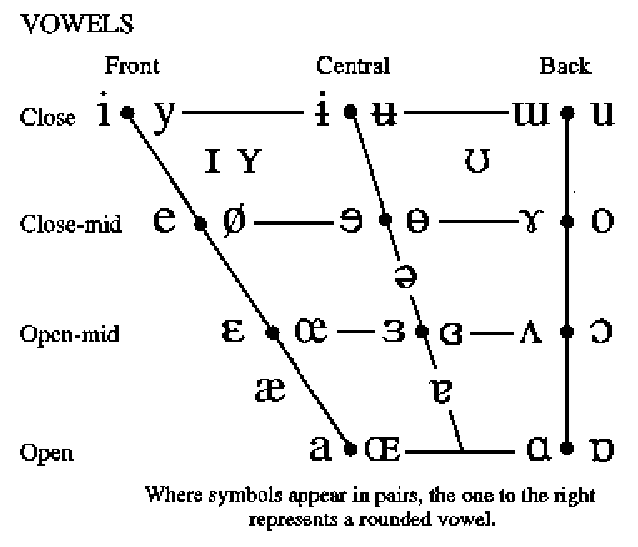The subject-matter of Phonetics. Branches of Ph. Phonetics is the study of the way humans make, transmit, and receive speech sounds. Phonetics studies the sound matter of a lang, the phonemes and their allophones, the syllabic structure the distribution of stress, and intonation, the sounds that are produced by the human speech-organs. Sounds of speech are segments interconnected with minimal distinctive units – phonemes. Supersegmental units- tone, stress, intonation are longer units of speech: syllables, words, intonation groups 2 participants in the passing of the spoken message: speaker, listener. Functions: creative, forwarding, hearing. Branches of Ph (types; levels of communication; methods of investigation): 1. articulatory ph/physiological (quality of sounds) 2. acoustic (function of sounds. Method- acoustic physics) 3. functional/linguistic (Phonology, phonemes; functions of speech sounds) 4. auditory/perceptive (perception only) Phonetics=an independent branch of linguistics which studies and gives a systematic description of the sound structure of the lang. Structure: 1. speech sounds (production, perception, acoustic characteristics) 2. combinations of sounds (syllables, words, tone groups) 3. groups are characterized by: stress, rhythm, intonation 4. correlation b/n spoken and written lang Types of Ph: 1-4 + general, special (of a particular lang): descriptive (synchronic), historical (diachronic), comparative, dialectology (accents, dialects), normative, clinical, voice training, telephonic, speech recognition
| 2. Methods and devices of phonetic investigation. Links of Ph with other sciences Methods: direct, indirect. +auditory (perceptive), acoustic, articulatory (psychological), functional (linguistic) - method of direct observation (observing movements and positions of speech organs in pronouncing various speech sounds, analyzing one's own kinesthetic sensations during the articulation of speech sound in comparing them with auditory impressions). - indirect methods involve the use of instrumental techniques (laryngoscopy, photography, cinematography, X-ray). It is widely used in experimental phonetics. 2 methods are not opposite to one another. Acoustic phonetics comes close to studying physics and the tools used in this field enable the investigator to measure and analyze the movement of the air in the terms of acoustics = a microphone and analyzing the result in terms of frequency of vibration and the amplitude of vibration. +spectrograph +pitch by intonograph +speech-synthesizing devices. Devices: articulatory (production) – physiology (photos, mirrors) acoustic (perception) – technical devices (comp. intonographs) functional (linguistic) auditory (perceptive) Place pf Ph. Non-linguistic: acoustic, physiologic, psychological, logic, sociology, dialectology. Ling: Grammar (past, pl, irr, parts of speech - through rules of reading, sound interchange, intonation), Lexicology (stress, homographs, homonyms), Stylistics (intonation: speech melody, rhythm, pausation= emotions, utterance; repetition)-phonostylistics
| 3. Rus. & E.cons-s: Princ.dif-ces. The E. foreling.c-s are artic-ed with the apico-alv-ar pos-n of the tip of the tongue, R. – mainly dorsal; in the prod-n of the R.c-s the bulk of the tongue is mainly in the front-mid part of the mouth resonator; E.foreling.c-s – the tip of the t. & front edges are very tense - depression in the front part of the tonge, which enlardes the size of the front resonator and lowers the tone of the apical con-s; E.’soft’ c-s are pron-ed with the front sec-ry focus (formed by the middle part of the tongue which produces 2-ry art-n sim-sly with the primary focus & primary art-n; Russian ш’, ж’ are long; bilabial w; E.con-s more energetic; big table – voiced remains. Mistakes: dorsal art-n of the foreling apical [t,d]; the use of R.rolled [p] inst. of the E.post-alv constr [r]; glottal fricative [h]; interdental s-s; the use of the forling [n] instead of the backling.velar [nг]; R. dark [ш,ж] ins of the soft E. [ш’,ж’]; labiodental [ф,в] ins of the bilab [w]; [p,t,k] – absence of aspiration; weak pron-n of voiceless fortis [p,t,k,f,s,ш,ч]; devoicing of voiced [b,d,g,v,z,ж,дж] in the terminal position.
| 4. Classification of English consonants. Main principles of consonant classification. There are 21 consonant letters., 24 sounds in most E accents. Articulatory differences b/n vowels, cons and sonorants depend on 3 articulatory criteria: the presence/absence of an articulatory obstruction to the air stream in the larynx or in the supra-glottal cavities the concentrated or diffused character of muscular tension the force of exhalation = consonants= sounds in the production of which a) there is an articulatory obstruction to the air stream (complete, incomplete, the combination of the two /t∫, d3/, intermittent) b) muscular tension is concentrated in the place of obstruction c) the exhaling force is rather strong From a phonological point of view: - cons. Are the units of the sound s-m which typically occupy the edges of a syllable (flat, black) - cons. May appear in clusters (sequences of 2-4 sounds) (the twelfths) Classification of cons.: 1. voicing (work of the vocal cords & force of exhalation): voiceless-fortis, voiced-lenis. 2.place of articulation (where the air is impeded): -bilabial(2 lips) p-b -labiodental(upper teeth-lower lip) f-v -dental(teeth) ð,θ -alveolar t-d,s,n,z,l -retroflex(tip of the tongue curved&moved backwards) r -palato-alveolar(middle tongue to the hard palate) тч,дж,ш,ж -palatal(to the soft palate) j -glottal h(pharyngal) -velar(back of the tongue) k,g, ŋ -labiovelar w 3.manner of articulation(kind of construction made by articulators): -occlusive: plosives (pbtdkg) & sonorants-nasals -constrictive: fricatives (fvszhðθшж) & semi- vowels (approximants) jwr+lateral l -occlusive-constrictive (affricates) тч дж
| 5. Classification of English vowels. Main principles of vowel classification. We have 6 vowel letters (a,e,i,o,u,(+y in the middle position)) and 20 vowel sounds (in Br.E.) 12 monothongs, 8 dipthongs+5 tripthongs. Monophthongs possess 1 principal vowel quality, diphthongs – 2 (nucleus+glide) Vowels=sounds articulated with no impediment to the airstream (the air passes freely through the vocal organs)+voice is created by the vibration of the vocal cords in the glottis+all vowels are produced by exhaling the air (egreesive airstream). From the phonological point of view:vowels tend to occupy the middle position of the word,the middle of a syllable(contrary to consonants). All Eng.v. are oral (no nasal) = the soft palate is raised=the air passes freely through the mouth cavity.If v. are in a position close to nasals,the vowel “a” will be a nasalized allophone. Classification of vowels: 1.position of the lips (rounded: completely [u:], slightly [ΰ]; or spread) 2.position of the tongue (front: fully, retracted;-central-back) 3.vertical movement of the tongue(close/high-mid-open/low) 4. the degree of tenseness (tense=long/lax=short)-the character of the end of the vowel (checked=all Engl short vowels are checked when stressed-free=all long vowels are free) 5.length (long&short) 6.stability of articulation (mono-, depth-, tripthongs) The Cardinal Vowel system devised by D. Jones. Daniel Jones(1881-1967). The basis of the system is physiological. Card.V.1 corresponds to the position of the front part of the tongue raised close to the palate.Gradual lowering to the back lowest position gives Card.V.5.Lowest front position-Card.V.4.Upper back limit-Card.V.8.This system is an international standard,but its practical application is limited to purely scientific work. 
|
| 6. Phonology. The relationship between phonetics and phonology. Pronunciation is smth that describes sounds. It can be studied from phonetic and phonemic points. Phonetics studies the way the sounds are produced, transmitted and received. Phonetics – the study of the way humans make, transmit and receive speech sounds. It studies sounds as articulatory and acoustic units. The unit – a speech sound. Phonology – the study of the sound system of the language. It studies only those contrasts in sounds, which make difference of meaning within the language. It investigates sounds as units, which serve communicative purposes. The unit – a phoneme | 7. The phoneme as an oppositional unit of sound. Main trends in phoneme theory. The phoneme is an oppositional unit of sound. Phoneme = ideal, sound = material. The phoneme is the least meaning-distinguishing speech unit. It can be discovered by the method of minimal pairs - finding pairs of words, which differ only in one phoneme. (fan/van). [subminimal pair - differ in more than one phoneme]. A minimal pair is discovered through a minimal set – a chain of words, which differ in one phoneme (fan/ van/ pan/ ran/ tan). Views of the phoneme. Mentalistic/psychological. The Phoneme – an ideal “mental image” or a target at which the speaker aims. Allophones – different materialisations of it. (I. A. Baudauin de Courtenay). Functional. The Phoneme is the minimal sound unit by which meanings may be differentiated without much regard to actually pronounced sounds. Meaning differentiation is taken to be a defining characteristic of phoneme. This view gave rise to phonology. (N. Trubetskoy, L.Bloomfield, R.Jakobson, M.Halle). phoneme not= a family of sounds Abstract. The Phoneme is essentially independent of the acoustic & physiological properties associated with them, that is of speech sounds. (L.Hjelmslev, H.J.Uldall, K.Togby). [These views of phoneme = idealistic] Physical. The Phoneme is a family of related sound, which 1. show phonetic similarity to one another; 2. can’t occur in one and the same phonetic context. (D.Jones, B.Bloch, G.Trager). Dialectical view - The most suitable for the purpose of teaching is conception by L.V.Shcherba: the Phoneme is a dialectical unity of functional, materialistic and abstract aspects. Phoneme. patterns of distribution: free (one and the same phoneme pronounced differently) – complementary (or this or no) – contrastive(minimal pairs)
| 8. The difference between phonemes and allophones. Classification of allophones. There is a great number of sounds in actual speech, which are combined into a certain amount of types. These types are phonemes. Their realisations in actual speech are allophones. e.g. take – aspiration; twice – rounded lips; button – partially through nose; cattle – laterally; Betty – partially voiced; eighth – dental; stone – no aspirtion. Allophones. 1.principal/typical. The allophones that do not undergo any distinguishable changes in the chain of speech, free from influence 2.subsidiary. The allophones that undergo predictable changes in the articulation under the influence of the neighbouring sounds in different phonetic situations. 2a. positional (historical “l” initial – “l” dark terminal); 2b. combinatory appear in the process of speech (let them) The procedure of identifying phonemes: the arranging of sounds into functionally similar groups (contrastive sounds or allophones of 1 phoneme): if or different sounds occur in the same ph.cont. they should be alloph.of diff. ph. Their distribution is contrastive. if or similar speech sounds occur in diff. positions and never occur in the same ph.cont. they are alloph. Of 1 ph., their distribution is complementary. - the semantic method – the commutation test
| `9. Pronunciation. Phonemic and phonetic transcription. The Phonemic Chart. Phonemic /tu:/ shows the phonemes that change the meaning Phonetic [twu:] emphasizes some particular things about some phoneme The English Pronunciation Dictionary was 1st published in 1917 by Daniel Jones (prof.of phonetics at Uni Coll.London) His own last edition – 12th. A.C.Gimson – 13th. The EPD – a classic work for reference for native speakers and language learners. The aim of the 15th ed. – to include info relevant to the needs of contemporary user and presented in the clearest way. – 18 000 new entries (science & techno; people & places; geo names; international cuisine; literature & law revised &updated; AmE spelling and vocabulary added; computer terms – a database for computer-based research) – 80 000 E words &phrases – Br & Am pron-n – pr-n of proper names &inflected forms Public School Pron-n – in 1926 PSP-RP Model BrE – BBC Model AmE – General American This edition doesn’t give the phonetic transcription of all foreign words Phonemic principle of transcription; rarely phonetic aspect [].
| 10. The International Phonetic Alphabet and its structure In 1886 Paul Passy (French), Henry Sweet (Engl), Wilgelm Vietor (Germ) set the IPA. They proclaimed: 1.the study of spoken lg. 2.phonetic training in order to establish good pronunc-ion. 3.the use of conversational texts & dialogues to introduce the conversational phrases. 4.iductive reproach to the teaching of grammar (fr the simplest to the most diffic.) 5.Teaching new meanings through establishing associations within the target lg., rather than finding equivalents, no mother tongue. So that’s how the Intern Phon Alphab appeared. 1886 – the start of Phonetics. IPA was developed with the intention to give students & linguists an opportunity to learn & record the pronunc-ion of lg-s accurately. Thus avoiding the confusion of contradictory conversational spelling & a multitude of individual transcrip. system. The aim of IPA was to provide the unique symbol for each distinctive sound in a lg. IPA primarily uses Roman characters, other letters are borrowed fr differ scripts (Greek) & are modified to conform to Roman style. Diacritics are used for fine distinction in sound & to show nasalization of vowels, stress, length & tones. The IPA chart contains all the basic tools needed to transcribe speech sounds, can be used for broad (phonemic) & narrow (allophonic) transcription: consonant symbols for primary or basic articulations in the main grid additional symbols which do not fit the grid (like double articulations), diacritic marks to modify all the basic symbols (vowels and consonants), vowel symbols, symbols for the tone and intonation. The IPA hasn’t had a success. It’s used less commonly in the USA than in Europe. One of its principal disadvantages is its utilization of large number of special symbols in addition to the letters of Roman Alphabet that constitute its core. The structure of the chart: the main grid – all consonant sounds pronounced with the air coming from the lungs (pulmonic). They are organized according to the place of articulation and organ, manner; voiceless on the left, voiced on the right non-pulmonic other symbols which don’t fit into the cl-n the vowel diagram – all vowel symbols diacritic marks – are used in writing in a narrow phonetic transcription to identify the specific pronunciation suprasegmentals – melody, stress, pitch, pauses, tones and word accents (level, contour)
|
| 11. Articulatory variations in connected speech. The nature of articulatory variations. Accomodation. Assimilation. The nature of articulatory var-ions: 1.Allophonic, 2. Phonemic, 3. Independent. Allophonic: sounds may lack 1 or more of their non-distinctive features (take, tube, stamp, twice); sounds may acquire some other features characteristic of neighboring sounds (twice – partially devoiced) Phonemic: A phoneme may be replaced by another phoneme, thus changing completely the phonemic pattern of a given word. Ex.: light candles & like candles; A sum for… & a sun for… Only a repaid colloquial pronunciation. The ambiguity is solved by the context: 1. Asking if she wants to g with us. 2. I can pose music for TV programmes. 3. I picture book off the table. Independent: Certain allophonic variants of E. phonemes cannot be interpreted as the natural result of a mutual influence with neighbouring phonemes in connected speech. Ex.: Eng. voiceless plosives (p,t,k), they are aspirated in the initial position,when followed by a stressed vowel & non apirated in final position. Speech sounds influence each other in the flow of speech. As a result of the intercourse b/w cons-s & vowels & within each class there appear such features of connected speech as: assimilation, accommodation, vowel reduction, elision. assimilation – a phonetic process by means of which 2 or more phonemes when joined together within the word or at word boundaries influence one another in an effort to achieve some degree of similarity: progressive: the 1st of the 2 sounds makes the 2nd sound similar to itself eg ducks, dogs regressive at the reciprocal twice, tune, dew allophonic/ partial assimilation phonemic/ total synchronic/contextual: established eg used to or accidental eg hit parade historical accommodation – the process of accommodating sounds due to the surrounding sounds nasalization of vowels eg never, men labialization of consonants eg twilight, tube vowel reduction elision (deletion)
| 12. Coarticulation as a feature of connected speech. Elision
| 13. Modifications of consonants in connected speech. Voice Partial devoicing of nasals & semi-vowels when preceded by voiceless stops or fricatives: Ex.: play, cream, smile, snow, at least, at what time, like you. the nature of the release unreleased ( ex.: /p/ stopped, /b/ robbed) released with aspiration (ex.: town) released laterally (ex.: simple, cattle) released nasally (ex.: sudden, not me) position of the lips (ex.: twice) position of articulation
| 14. Modifications of vowels in connected speech All vowels in unstressed syllables are reduced. Reduction – a historical process of weakening, shortening or disappearance of vowel sounds in unstressed position. quantitative – the decrease of the vowel quantity or shortening of the vowel length qualitative- unstressed v. lose their quality to shwa zero reduction “(v. elision)- in rapid colloquial speech the complete omission of unstressed vowels. The articulatory & acoustic features of vowels may be modif. By adjacent cons-s. The most import. are: 1. degree of opening Visibility, set-sell 2. place of articulation university, yard – back again 3. nasalization sing, mean 4. variation of length - position in the word ex.: sea-seed-seat -
| 15. Prosodic features of Lg. In general prosodic features of speech can be: melody, pitch of the voice sentence stress or accent temporal characteristic: tempo, duration, pausation, rhythm tamber (voice quality) Pr. Features are divided into: pros. elements (are derived from the acoustic characteristic of speech. They include: the pitch of frequency, the length of duration, the loudness or intensity) & pros. functions (they are many & varied). Pros. features can include: syntax, turn taking in conversation, ppl’s attitude & feelings. Hierarchy (prosodic): syllable- foot- accentual phrase- intermediate phr.- intonation phr.- utterance. Pros. functions can be: chunking (speech is divided into chunks so that each chunk sounds complete. Chunks: into-units, tone-units, inton. phrases, word groups). Focus (may be described as the most important item in an utterance. It is signaled by prominence or highlighting. (accent, nucleus, stress, emphasis – prominence)) Constructive focus may be broad & narrow (one part of the utterance is particularly emphasized at the expense of the rest. (Ex. You went for 2 weeks? Bill went for 2 weeks & I went for three.) Tone languages: changing the meaning by changing the pitch. Chinese mandarin.
|
| 16.Intonation. Stylistic use of intonation The music of a l-ge. Is very imp-t, cause it may effect the meaning. How we say. The segments of spoken l-ge are v-s & c-s – produce syl-s, w-s, s-ces – the verbal aspect of speech. We articulate them, a voise effect, extending over more than 1 segment – suprasegmental analysis. I-n – a complex unity of non-seg-l or prosodic features of speech (do not exist in isolation). Term prosody (acoustic properties of the speech, the el-s of pr-dy are derived from the acoustic ch-s of speechis wider than in-n: just the changes in the pitch. Approaches: 1) contour analysis (H.Sweet, D.Jones, Palmer, J.O’Conner; the smallest unit to which ling-c meaning can be attached is a tone-group (sense-group), based: in-n consists of basic functional blocks; traditional & widely used); 2) gram-l (Halliday; the main unit of I-n – clause; based on syntactical f-n of in-n; tied with gram.categories: tonality – marks the b-g & the end of a tone group; tonicity – marks the focal point of an in-n group; tones – may be primary or sec-ry; 3) functional (O’Conner, Alexander; based on discovering the links of the voice of the speeker – his attitude, without context); 4) contextual (D.Brazil, Barbara Bradford; context.signif-ce of I-n, meanings are like surprise, irony are features of particular context, major components – prom-ce, tone, key (pitch levels)-high\low key inf-n, termination (result). Stylistic use of intonation. Depends on extra-ling factors (purpose of communication, social circumst., age, status, occupation, speech habits, emotional state of the speaker). Intonational style-system of interrelated Intonational means, which is used in a certain social sphere and serves a definite aim in communication. Style – different manner of non-verbal expression. The choice of a speech style is situationally determined. Any act of verb.com-n is changed by certain int-nal peculiarities which depend on such extra-ling-c factors (effect the situation) as: 1) the purpose of com-n; 2) social setting of circumstances; 3) social identity of the speaker; 4) individual speech habits; 5) emotional state of the speaker. An int-l style – a s-m of interrelated int-nal means, which is used in a certain social sphere and serves the def-te aim of com-n. The problem of ontnationsl styles isn’t regarded as settled yet. Clas-n by Sh.Bally: 1) highly elevated style; 2) elaborate pron-n (тщательное); 3) slow coll.pron-n; 4) fluent coll.pron-n. Clas-n by Sokolova, Gintovt, Kanter: 1) informational – formal; styl.neutral; radio, press; 2) scientific – accad.; scientific reports, lectures, explanations, exam answers 3) declamatory (emotions than thoughts); artistic, stage style – st-ly highly emotional and expressive, the stage, screen, public recitations 4) publicistic; oratorical style, publicisctic speeches 5) familiar (conversational) natural, spontaneous everyday speech. Based on.. that 3 types of Info: intellectual, emotional, volitional.
| 17.RP – helps p-le to understand each other. Features: phonologically neutral; non-rhotic variant of r; bath,dance; strong socio-ling-c marker. Early ch-es (1900-40) [o:] shorter; don’t go home alone; лягушка протяжнее; r исчезла раскатистость. Ch-es (40-70): sure poor tour- shore, pour, tore; I в безуд.поз. усечён. – carelessness; sibilant – prince-prints; graduate; glottal stop – quite nice. Ch-es (70-pres.) I – more intensive – happy, coffee; goose, foot – oo – потеря лабиолиз-и; gl.stop not only, but also; [l] - [w]; Tuesday - Chooseday, reduce - rejuice. Both the words and pronunciation of many individuals reflect the person’s social position. It is agreed that in England, the "phonetic factors assume a predominating role which they do not generally have in North America. In Britain the middle class is associated with having not only a standard accent, but with also speaking in a more "formal and abstract style than working class." Accents are often characterized by British speakers themselves as either "posh" or "common" accents. Most speakers of British English would recognize these labels and create a fairly accurate image of the sound of these far ends of the spectrum. Conservative or U-"Received Pronunciation" representing the "posh" end and a less broad version of Cockney representing the "common" accent. RP is only really associated with England and not the other countries of Great Britain. However, it is not associated with any particular location within England. Because it is what might be thought of as an "educated accent" it appears characteristically in upper and upper middle class speakers and is more sociologically defined rather than geographically defined, going by such varied labels as the 'Oxford accent', 'BBC accent', the 'King's/Queen's accent', and 'public-school accent'. RP is an accent that is not localizable but is very recognizable as being the standard, neutral accent of the society. It is not, however, used by a large percentage of the population. A reason posited for the growth of Estuary E, especially among young people, is that it is said to "obscure social origins and is very often adopted as a neutral accent." Those who have come from a traditional RP background, adopt it because it increases "street credibility," and those who have local accents adopt it because it sounds more "sophisticated." Rosewarne thus sees the acquisition of Estuary E. as part of the process of accommodation and a shift to the "middle ground" so that the RP accent is accommodated "downwards" and the local accent is accommodated "upward", resulting in accent convergence. The sociolinguistic consequences of this are that for over a decade, it has been common for the young people in the south eastern segment of England to speak differently from their older family members. This somewhat "new" accent has also been heard on the BBC (British Broadcasting Corporation), by members in both the House of Commons and the House of Lords in Parliament as well as by business men in the "City".
| 18. Modern English. Br. And Am. Internationa. Varieties, spread of English. English (E.) is spoken in Great Britain, the USA, Australia, New Zealand and the greater part of Canada. It is native to many who live in India, Israel, Malta and Ceylon. All the national varieties of E. have very much in common but they differ from standard pronunciation. ‘Standard’ pron-tion is the pron-tion governed by the orthoepic norm. It is the pron-tion of the educated circles or used by radio, television and is regionally neutral. Nowadays 2 main types of E. are spoken in the English-speaking world: English-English and American-E. According to Brit. dialectologists the following variants of E. are referred to the E.-based group: English-E., Welsh E., Northern Ireland E., Australian E., New Zealand E. + Scottish E., Irish E.; to the Am.-based group: US E., Canadian E..
In the Brit. Isles the regional types of E. are: the Southern E., the Northern E., the Standard Scottish, Welsh and Northern Ireland E.. In the USA the regional types of the American variant of E. are: the Eastern type, the Southern type, the General American type. The latter is the most wide-spread in the USA, used as the social standard. International E. E. has become lingua franca and is not taught as a foreign lang-e in many countries, including China and India. Instead it is seen as a “basic universal skill”. E. has official or special status in at least 75 countries with a total population of over two billion. E. is spoken as a first language by around 375 million and as a second language by around 375 million speakers in the world. Around 750 million people are believed to speak English as a foreign language American. Types: Eastern (New-York, resemblance to Southern E.), Southern (vowel drawl), General American (NY, NJ, Wisconsin. Vowels: no division short-long; diphthongs vary from 3 to 12 phonemes; Pron-n of r (turn, bird, star; murmur); nasalization of v-s – an Am.twang (take, small, name); front v-s (vary, pity; let); central v-s differ in art-n & distribution. Con-s: l - is fairly dark, t: twenty, little; winter=winner; r – greater retroflexed; wh; [j] is omitted b-n a c-t and [u:] – news, student, tube. Stress – on the final syl-le (ballet, beret; some w-ds are 1-stsylstr. – address, cigarette, magazine; ‘week-end, ice-cream, hot-dog; 2-d s-s – laboratory, dictionary, secretary. Intonation is similar. Vowels: no division short-long; diphthongs vary from 3 to 12 phonemes – GA 5 diphthongs [ei] [ai] [oi] [au] [ou]; Pron-n of r (turn, bird, star; murmur); nasalization of v-s – an Am.twang (take, small, name); But: I don’t want to go to the cinema. Do you like it? In GA the voice doesn’t fall to the bottom mostly. Open the door – RP Rise, GA Fall-Rise.
|
|
|




























